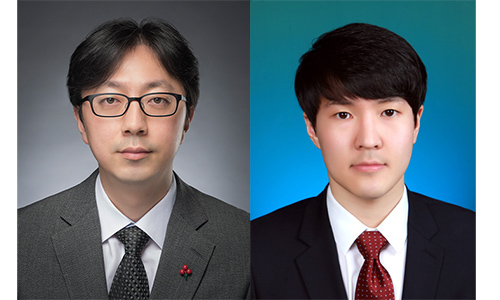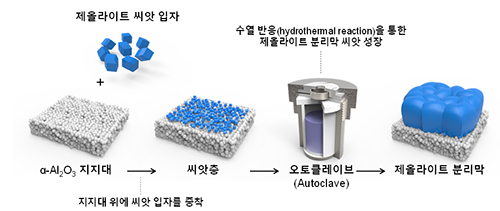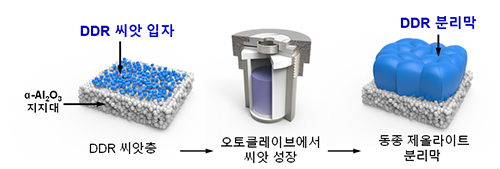Professor Jungkyu Choi’s Group Developed Excellent Hybrid Zeolite Membrane Technology
for Carbon Dioxide Separation
Professor Choi’s group published their research results online in Angewandte Chemie International Edition, which is a prominent international journal in chemistry.

▲ Professor Jungkyu Choi (left) and Yanghwan Jeong (right) of the Integrated Master & Doctoral Degree Program
in the Department of Chemical and Biological Engineering, College of Engineering.
Led by Yanghwan Jeong, a student in the Integrated Master & Doctoral Degree Program, in Professor Jungkyu Choi’s group in the Department of Chemical and Biological Engineering, College of Engineering, the research team developed a method for preparing a hybrid zeolite membrane that has an excellent carbon dioxide separation performance.
Compared to the conventional separation processes such as adsorption, distillation and recrystallization, a zeolite membrane-based separation process can be operated in a more energy-efficient manner. Based on this advantage, a zeolite membrane-based separation process allows one to operate the process flexibly to address the space limitation problem of the large-scale conventional separation processes. In particular, the DDR (deca-dodecasil 3 rhombohedral) type zeolite crystals include nano-sized pores that are suitable for the separation of carbon dioxide, and thus have great potential for selectively and effectively removing carbon dioxide when the crystals are prepared as a continuous membrane. Therefore, the preparation of a continuous membrane consisting of the DDR crystals can enable one to selectively separate carbon dioxide based on the role of the membrane as a molecular sieve that separates molecules included in mixtures, such as a carbon/methane mixture and a carbon dioxide/nitrogen mixture that are used in various industrial fields, according to the different sizes of the molecules.
※ Zeolite: An inorganic crystalline material of silicone oxides where some of the silicon atoms are replaced by aluminum atoms. Zeolites have pores that are smaller than 1 nm. More than 200 independent structures of zeolites have been reported because they have unique crystalline structures. The structures are represented by 3-letter codes (e.g. CHA (Chabazite), DDR (Deca-dodecasil 3 Rhombohedral), MFI (Zeolite Socony Mobil-five) and LTA (Linde Type A)). Zeolites are widely used in various fields as ion exchangers, catalysts and catalyst carriers, adsorbents and membranes.
However, despite the high potential of the DDR zeolite membrane, the technology to prepare DDR zeolite crystals in the form of a membrane and apply the membrane to an industry-scale carbon dioxide separation process has been possessed by only one Japanese company until now. This is because of the absence of a reliable methodology to prepare a high-performance DDR zeolite membrane faultlessly, continuously, and reproducibly. The zeolite membrane synthesized by the seeded growth (secondary growth) methodology (consisting of two stages of seed layer formation and continuous homogeneous zeolite-based growth of the seed layer; see Figure 1) reproducibly shows the potential of giving a high separation performance. However, DDR zeolite crystal has rarely been used in the preparation of a membrane having a high separation capacity.

▲Figure 1. A schematic diagram of seeded growth (or secondary growth) methodology where a zeolite membrane is prepared
through the formation of a seed layer and a continuous homogeneous zeolite-based growth process of the seed layer.
Zeolite membranes are normally prepared by using the seeded growth method, which has the limitation that the zeolite that forms the seed particles should have the same crystal structure as the zeolite constituting the membrane (*see Figure 2). The previous methods for synthesizing the DDR zeolite particles are highly complicated and difficult. Even if the synthesis is carried out, the considerably low reproducibility puts another obstacle in the way of utilizing the DDR zeolite as a membrane. In addition to the drawback that the seed layer should be formed with particles that have the DDR structure, the difficulties involved in the preparation of a continuous DDR zeolite-based membrane through the seeded growth method using the particles creates another level of problem that needs to be solved.

▲Figure 2. A schematic diagram of preparing a homogeneous DDR zeolite membrane by forming a DDR zeolite seed layer
and then implementing seeded growth based on the homogeneous DDR zeolite.
Professor Jungkyu Choi and Yanghwan Jeong of the Integrated Master & Doctoral Degree Program thought that resolving the problem directly is not appropriate from the engineering point of view. Therefore, they decided not to use as the seed particles the particles of the DDR zeolite structure, which is difficult to synthesize using existing methods and which has a low reproducibility. Instead, they decided to use as the seed particles the SSZ-13 (standard oil synthetic zeolite-13) zeolite particles of the CHA (chabazite) crystal structure, which can be synthesized by a simple method, has a high reproducibility, and provides particles of a small and uniform size that are suitable for seed particles. Breaking free from the conventional framework, they employed a new method for growing a zeolite membrane of the DDR structure from the SSZ-13 seed layer to prepare in an easy and reproducible manner a hybrid zeolite membrane that has both CHA and DDR zeolite crystal structures (*see Figure 3). The new structure is similar to the core-shell structure of hybrid zeolite, which is well known as a catalyst or adsorbent. In addition, the hybrid zeolite membrane was prepared to have a high hydrophobicity to prevent the decrease of the separation performance by the water vapor that is produced with carbon dioxide when carbohydrates are oxidized.
In addition, the authors verified that the hybrid zeolite membrane can selectively separate carbon dioxide from mixtures containing carbon dioxide, particularly from carbon dioxide/nitrogen and carbon dioxide/methane mixtures. They also verified that a negative effect of water vapor on the separation performance, which is neglected in many studies, is absent. The present study was supported by the Korea Carbon Capture & Sequestration R&D Center (KCRC; President Sangdo Park), the Leading Research Center Program (ERC Super Ultra Low Energy and Emission Vehicle Center; President Kwan Young Lee) and the International Cooperation Program of the National Research Foundation of Korea.
The results of the present study were published online in Angewandte Chemie International Edition, a prominent international journal in chemistry, on October 7 (*Title of article: An Unprecedented Hetero-Epitaxially Grown Zeolite Membrane).

▲ Figure 3. A schematic diagram of preparing a CHA-DDR hybrid zeolite membrane by using the seed particles
of the CHA zeolite structure to form a membrane of the DDR structure that is effective in carbon dioxide separation.
SSZ-13 zeolite seed particles of the CHA structure were uniformly deposited on a porous support, and then a precursor solution that can make the DDR structure grow was used to grow the seed particles to become a continuous zeolite membrane. A CHA-DDR hybrid zeolite membrane that has two different crystal structures was effectively obtained by the method. In particular, thanks to the DDR zeolite structure that accounts for most of the membrane, the hybrid zeolite membrane should have an excellent carbon dioxide separation capacity.
Explaining the significance of the study, Professor Jungkyu Choi said, “Our first author, Yanghwan Jeong, whose major was chemistry, synthesized for the first time in the world the hybrid zeolite membrane that has such a unique structure. It was possible because the first author, who had majored chemistry in the undergraduate school, had the goal of developing a technology required by the industry, while studying at the graduate school in the department of Chemical Engineering, based on his basic knowledge of chemistry. Because the technology has a high reproducibility in the preparation of the membrane, the membrane may be applied to any areas where the separation of carbon dioxide is needed.



